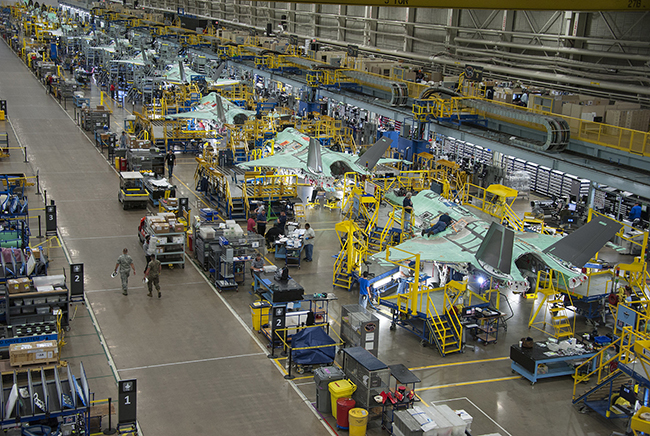
More than 300,000 parts from aerospace leaders across the industry go into the F-35’s assembly. Here, the jet comes together at Lockheed Martin's Fort Worth, Texas, production facility. Lockheed Martin photo.
Lockheed Martin has made its opening offer to the F-35 Joint Program Office for negotiations on production Lots 12-14, and it expects to deliver on its previous agreement to get to $80 million a copy or less—for the airplane and engine—by 2020.
“We currently have an offer submitted to the Department of Defense for Lots 12-14 that is below the $80 million F-35A for Lot 14 in 2020, per our longstanding agreement,” company spokesman Michael Friedman said in an email.
In Lot 11, the unit price for the F-35A—the conventional takeoff and landing version used by the Air Force and several partners and foreign military sales customers—was $89.2 million, a decrease of 5.2 percent from Lot 10. Over the next three lots, Lockheed aims to lower the unit price a total of 10 percent further, Friedman said, or an average of 3.3 percent per lot. Compared to the initial contract for the first lot, the unit price will have fallen 75 percent.
Those numbers don’t assume any increase in the US fiscal 2020 buy if Congress opts not to purchase F-15EX fighters for the Air Force or boosts the planned purchase of 48 F-35s to 60.
Lots 12-14 also mark the start of the so-called “block buy,” which is being undertaken by most of the F-35 partner countries. By agreeing to pool three years’ worth of purchases, they will receive what amounts to a quantity discount from Lockheed. The US can’t participate in the block buy yet, because US law prohibits entering what is known in the US as a “multiyear contract” until after full-rate production is achieved. That happens next year. Nevertheless, the US can benefit from the quantities its F-35 partners are buying. A total of 385 F-35s have been delivered to all customers so far.
The company also is “taking action to deliver on the $25,000 cost per flying hour goal by 2025,” Friedman said. Lockheed has reduced the cost per flying hour by 15 percent since 2015, but Friedman noted the company controls less than half of the cost of operations and sustainment. Of the rest, about 15 percent is accounted for by Pratt & Whitney (who makes the F135 engine for the fighter) and the remainder is other parts and service vendors.
“We are applying the same rigor and innovation to reduce sustainment costs” as to reducing procurement costs, Friedman asserted.
Last week, Pentagon Cost Analysis and Program Evaluation chief Robert Daigle told a House Armed Services Committee panel his office does not “see a path” to get below $25,000 per flying hour on the F-35 by 2025. He said his office anticipates the true cost will be $36,000 per flying hour, in the same ballpark as the JPO’s estimate of $34,000 by that date. Vice Adm. Mat Winter, JPO director, told the panel the current cost per flying hour is $44,000, and said his organization is still trying to hit the goal of $25,000 by 2025, but he is not optimistic it can be achieved. Daigle said the CAPE expects F-35 sustainment costs to level off after 2025, because the oldest jets will by that time need more modifications and repair.